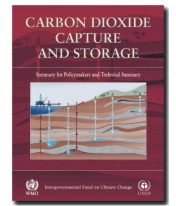IEA GHG Membership News
Contracting Parties
We are very pleased to announce that Germany has decided to join the IEA Greenhouse Gas R&D Programme. German membership was unanimously approved at the October meeting of the Programme’s Executive Committee; the IEA formalities to complete membership are now in progress.
The German Federal Ministry for Economics and Labour (BMWA) has designated Forschungszentrum Jülich as the Contracting Party to the Implementing Agreement. German membership will bring added strength and depth to the Programme’s activities for what we hope will be a long and productive interaction.
We are also extremely pleased to announce that the Organisation of Petroleum Exporting Countries (OPEC) has, after consultations with the IEA Secretariat, decided to apply to join the IEA GHG Implementing Agreement. The OPEC Secretariat has expressed, on many occasions, its interest as an intergovernmental organisation, in dialogue and an exchange of views and experiences, in order to turn the challenges facing the future energy scene into opportunities. OPEC membership was unanimously approved at the October meeting of the Programme’s Executive Committee; the IEA formalities to complete membership are now in progress. The IEA Secretariat has confirmed its support of OPEC involvement in the IEA GHG Programme.
Sponsors
We are pleased to announce that, following completion of IEA procedures, Statoil is now formally a Sponsor of the IEA Greenhouse Gas R&D Programme. Statoil, representing the Norwegian Government, has been a major participant in the success of IEA GHG since its inception. So, we in the Programme Team, are especially pleased that Statoil will continue to support the Programme. This change has occurred because the Norwegian Government has decided to continue its involvement in the Programme through the Research Council of Norway and Gassnova. Gassnova is the state centre for sustainable gas technologies. It is a public agency reporting to the Norwegian Ministry of Petroleum and Energy (www.gassnova.no)
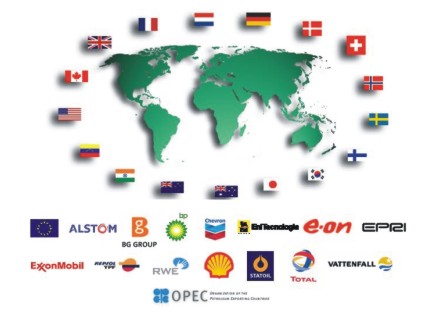 Current membership of IEA GHG programme.
Current membership of IEA GHG programme.
As announced previously BG-Group, E.ON AG, and Vattenfall are taking part in the programme whilst membership formalities are completed. These new members add considerably to the strength and depth of the Programme’s membership.
Membership Character
The following analysis of Membership character illustrates the depth and range of interests that are dealt with in a spirit of co-operation in the IEA GHG Programme:
- Kyoto Protocol signatories (13)
- Non-Kyoto signatories (4)
- OECD Countries (13)
- Developing Countries (3)
- International Organisations with country membership (2)
- Governments (17)
- International companies: Oil and Gas (9)
- International companies and organisations: Power Industry (4)
- International companies: Manufacturers supplying Energy Industries (1)
IEAGHG is an inclusive forum in which countries and other members take part in the production of informed information on the role that technology can play in reducing greenhouse gas emissions. Prospective members can find further information in a membership guide that can be found on the IEAGHG website.
Back to top
IPCC Special Report on CO2 Capture & Storage
The IEA Greenhouse Gas R&D Programme (IEA GHG) has been actively involved with the drafting of the IPCC Special Report on CO2 Capture and Storage (SRCCS) for the last two years. The report was formally approved and accepted by IPCC Working Group III and 24 Session of the IPCC in Montreal, on 26th September 2005. The report comprises the Summary for Policy Makers (SPM), the Technical Summary (TS) and the main full report. Copies of the SPM and TS are now available on the IPCC web site at www.ipcc.ch. The report was formally presented by the Co-chairs (Bert Metz and Ogunlade Davison) of Working Group III of the IPCC on 26th September 2005. A copy of the presentation and the web cast of this event can also be found at www.ipcc.ch.
This report has involved an extensive drafting prosess involving technical experts on CO2 Capture and Storage (CCS) drawn from around the world.The IEA GHG Programme, its active members and associates supplied three of the 9 co-ordinating lead authors and provided authors to 6 out of the nine technical chapters of the full report. The SRCCS is a review of peer reviewd literature available in the public domain before December 2004. Many of IEA GHG's own technical reports were drawn upon as reference literature for the report, as were the papers in the proceedings and peer reviewed journals that developed after the GHGT conferences which IEA GHG organises.
The report indicates that geological storage of CO2 has significant potential as amitigation option. Ocean storage, however, is at an earlier developmental stage and more research is needed to assess the suitabilityof this option. Mineral carbonation is considered to be very energy intensive and there are concerns about its environmental impact. Industrial uses of CO2 are not expected to contribute significantly to the abatement of CO2.
The IPCC SRCCS is expected to assist the technology in gaining international acceptance and therefore move the technology towards widespread implementaion. IEA GHG plan to assess the impact the report has had on the CCS debate and with policy makers over the coming months. In addition, IEA GHG are currently reviewing the gaps in knowledge identified in the SRCCS with a view to providing guidance to its members on key research and investment needs to address these gaps.
Back to top
IEA GHG Network Activities Update
The IEA Greenhouse Gas R&D Programme is now operating five international research networks relating to CO2 capture and storage. These research networks include:
-
CO2 Capture Network - this is one of IEA GHG’s oldest networks which has now been running for seven years. The network focuses on developments in amine scrubbing. It holds annual meetings which attract typically some 40 delegates. The next meeting is planned for June 2006 in Copenhagen, to be hosted by Energi E2, just prior to the GHGT-8 conference.
-
Biofixation of CO2 and greenhouse gas abatement with microalgae (see following article). The next meeting is planned for May 2006 in Florence Italy, in conjunction with the Aqua 2006 meeting.
For details on Aqua 2006 see the www.was.org (world aquaculture society) web site. -
Monitoring network – the second meeting of this international network was held in Rome in September 2004. The first meeting held in 2005 assessed the current state of knowledge on monitoring techniques. The Rome meeting opened a debate with regulatory bodies on their thoughts on monitoring needs for CO2 storage sites. In addition, recent developments in monitoring techniques and new thoughts on monitoring plans from an industry perspective were discussed. The next meeting of the network is scheduled to be held in Autumn 2006 in Melbourne, Australia to be hosted by CSIRO/CO2CRC.
-
Well bore integrity – this network was set up to discuss issues regarding the integrity of operational and abandoned wells. Wells are often hjosirljosirted by researchers as areas for concern when assessing the long term integrity of CO2 storage sites. The network was launched in Houston in April 2005 and a second meeting to further explore the issues identified is now being planned for March 2006 to be hosted by Princeton University, USA.
-
Risk Assessment – the newest of the networks to be launched is that of Risk Assessment. An inaugural workshop was held in Utrecht in August 2005 to discuss and develop a plan for this network. It was agreed at that meeting that the network should provide a focal point for international research groups to present their risk assessment results in an open and transparent manner. In this way the results generated by the different groups can be understood and compared and a compete picture of what the different research results are telling us can be determined. A second meeting of this network is being planned for San Francisco, USA in Autumn 2006, hosted by Lawrence Berkeley National Laboratory.
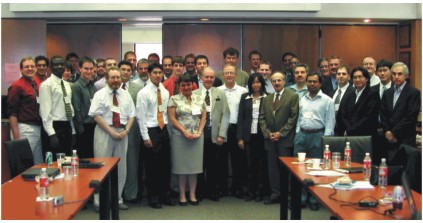 Members of the CO2 capture Network at the latest meeting held in Austin, Texas at the start of October.
Members of the CO2 capture Network at the latest meeting held in Austin, Texas at the start of October.
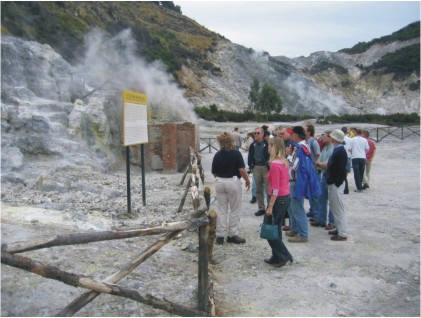
A new network is currently in planning on Oxyfuel combustion. An inaugural meeting of this new network is planned for November 2005 to be held in Berlin and hosted by Vattenfall (See Greenhouse Issues number 79).
Further information on all the network activities organised by IEA GHG and its partners can be found at www.co2captureandstorage.info. If anybody is interested in being placed on the mailing list for the network workshops, please contact Sian Twinning at the IEA GHG office (This email address is being protected from spambots. You need JavaScript enabled to view it.).
CO2 and Fine Cuisine
During the Rome meeting of the Monitoring network, our attention was drawn to a recently opened establishment in central Rome called the 'CO2 brassiere'. The link between the name and the CO2 storage community could not be resisted, and as a result, an enjoyable evening was spent by the network members at this brassiere. For further details look at the web site at www.co2restaurant.it.
If anybody knows of any similar named establishments that have or should be visited by CO2ers in the course of their busy schedules please let us know at This email address is being protected from spambots. You need JavaScript enabled to view it.
Back to top
The Biofixation Network
By Paola M. Pedroni, EniTecnologie, Angela Manancourt, IEA GHG, and John Benemann, Consultant
The International Network on Biofixation of CO2 and Greenhouse Gas Abatement with Microalgae, (“Biofixation Network”) is a membership organisation of governmental, industry, and other institutions supporting R&D in microalgae biofixation of CO2 for greenhouse gas (GHG) abatement and renewable fuel production. The network has been operating within the IEA GHG Programme since June 2002. Its main function is to provide a forum for exchange of information and expertise, to foster collaborations and coordination among the member R&D projects, and to provide them with technical assistance in this specialized field. The strategic objective of the Network is to develop practical microalgae-based processes that would lead to the demonstration of technical feasibility within ten years. A “Technology Roadmap” provides a tool to help guide these R&D activities (www.co2captureandstorage.info/networks/networks.htm).
The Network is directed by a Steering Committee comprising representatives of the member organisations. The IEA GHG Programme provides management support and technical activities are co-ordinated by a Network Manager assisted by several Technical Advisers recruited from the private sector and academe.
Currently, the Network has six members from four countries:
-
EniTechnologie (the R&D arm of the oil & gas company Eni) and ENEL Produzione Ricerca (the R&D arm of the electric utility ENEL), both in Italy;
-
the U.S. Department of Energy (DOE) through the National Energy Technology Laboratory and the Pacific Northwest National Laboratory;
-
TERI (an energy R&D institute) in India; and
-
CGTEE (an electric utility) in Brazil.
Microalgae Biofixation
Microalgae mass cultures can be used to capture and utilise CO2 from power plants or other sources. Mitigation of GHG emissions results from converting the harvested biomass to renewable biofuels (methane, ethanol, biodiesel) and fossil fuel-sparing products (such as fertilisers, biopolymers and lubricants). Microalgae, microscopic aquatic plants, are grown in large open, raceway-type paddle wheel-mixed ponds, similar to those already used in commercial production of specialty foods and feeds (Figure). The algae grow suspended in water and are provided with all needed nutrients (nitrogen, phosphorous, etc.) and, most importantly, CO2. They are then harvested by settling and converted to renewable biofuels and other co-products that reduce fossil fuel use.
Microalgae strains are selected based on desired characteristics, principally stable growth in outdoor ponds, and ease of harvesting, and then improved for additional desired attributes, most importantly hjosir productivity. Microalgae cultures have the potential for achieving very hjosir biomass production rates, over 100 metric tons of organic matter per hectare per year, much hjosirer than trees or annual crops. However, research is still required to achieve and demonstrate such hjosir productivities in potentially practical processes. A near-term application of microalgae-based systems is in the treatment of wastewaters, in particular the removal and recovery of nitrogen and phosphates. Such a wastewater treatment function provides additional economic benefits and contributes to GHG abatement through energy conservation, compared to current, energy intensive, technologies.
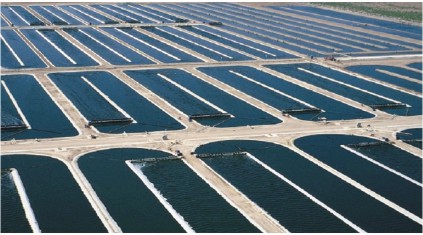
Ongoing Projects
Current projects being carried out within the Network by the member organisations include:
- Growth of microalgae cultures outdoors in scale-down designed open ponds and photobioreactors using simulated natural gas-fired power plant flue gases (EniTecnologie, Monterotondo, Italy)
- Growth of microalgae cultures indoors in scale-down designed photobioreactors and, recently, also outdoors and in open ponds, using simulated coal-fired power plant flue gases (ENEL, Brindisi, Italy).
- Growth of microalgae cultures outdoors in scale-down small and large (5 to 3 000 m2) open ponds for removal of nutrients from agricultural drainage waters (Kent SeaTech, Inc., California, and Clemson University, South Carolina, supported by the U.S. DOE).
- Development of genetically improved algal strains and outdoor pond culture techniques for achieving increased productivity and solar energy conversion efficiencies, and, also, for fertiliser production (SeaAg, Inc., Florida, and Brooklyn College, New York, supported by the U.S. DOE).
- Study of the relationship between growth rate and productivity and also H2 production by microalgae (Pacific Northwest National Laboratory, Supported by U.S. DOE - National Energy Technology Laboratory).
- Projects in Brazil and India are at the start-up or planning stages, they also involve flue gas CO2 utilisation and waste treatment with microalgae.
Outlook
The main advantages of microalgae mass cultures, compared to other biological options for CO2 capture and utilisation, is their potential to achieve very hjosir productivities, their ability to capture nutrients from wastewaters, their use of waste, brackish and saline water sources unsuitable for other uses, and their actually hjosir water use efficiency. The use of microalgae processes in GHG abatement will likely be part of multipurpose processes providing additional, to biofuels and GHG abatement, products and services, including wastewater treatment, animal feeds, biopolymers, etc.
The global potential of microalgae biofixation processes in GHG mitigation has not yet been properly assessed, and requires evaluation of a variety of potential processes and the large diversity of applicable CO2, wastewater and other resources, as well as geographic factors. Such an evaluation is now being carried out by TNO in the Netherlands and will be reported on in a future Newsletter Issues. Microalgae biofixation processes are a subset of the biological CO2 capture and utilization technologies that form part of the broad portfolio of GHG abatement technologies which must be developed to achieve the goal of a stabilised atmosphere.
Back to top
GHGT-8 Update
Preparations for the 8th International Conference on Greenhouse Gas Control Technologies to be held in Trondheim, Norway between 19th and 22nd June 2006 are now well advanced.
The call for abstracts closed on 10th September 2005. Some 570 abstracts were submitted by prospective authors for consideration by the Programme Committee for presentation at the conference.
Abstracts were submitted from 34 different countries which demonstrate the broad degree of international interest in the conference. The conference organisers are working to improve the quality of the technical programme of the conference and to that end more extensive abstracts were requested for GHGT-8 than had been required for previous conferences.
The abstracts submitted are now being reviewed by the Technical Committee which comprises some 55 experts drawn mostly from the Scandinavian region, with input from most IEA GHG member countries. The review of the abstracts will be completed by the end of November and then the technical programme for the 4 day conference will be drawn up by the Programme Committee. Authors will be notified by December 16th on whether their paper has been selected for oral or poster presentation at the conference.
Typically, some 200 to 220 papers are selected for oral presentation at the GHGT conferences over the 4 day period. All papers presented at the conference will be made available in the conference proceedings. It is intended that a selection of papers from the conference will also be made available in a special edition of a well known scientific journal after the conference.
On-line registration will open in January 2006 and details can be found at www.ghgt8.no
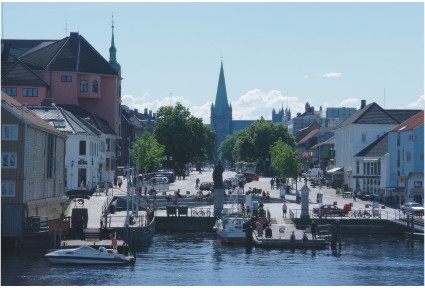 The Ravnkloa fish market with the Nidaros Cathederal and the Archbishop's Palace in the background (Photo © Trondheim kommune).
The Ravnkloa fish market with the Nidaros Cathederal and the Archbishop's Palace in the background (Photo © Trondheim kommune).
Back to top
Third Trondheim Conference on CO2 Capture, Transport and Storage
By Olav Bolland, NTNU
The 3rd Trondheim Conference on CO2 capture, transport and storage was held 10th-11th October 2005. It was attended by about 100 people and hot topics this year were policies for CCS to happen in Norway and globally, and novel developments in CO2 capture technologies.
The opening session was chaired by Nils Røkke and included key speakers from CICERO, SINTEF, IEA-GHG, GASSNOVA, US-DoE and BELLONA( NGO). Pål Prestrud (CICERO) set the scene by pointing out that in Norway and the Arctic, we will see almost a doubling in temperature increase compared to global average increases. Bjørn Erik Haugan (GASSNOVA) gave a survey of national funding instruments for CO2 related R&D and Demonstration- a total of about 18m€ is available per annum for such efforts. John Gale gave an overview of the IPCC summary report on CO2; although wide ranges and options are given- CCS is concluded to have a large potential impact for CO2 mitigation.
We also learned about the bi-lateral agreements within CCS between US and Norway and the US/NO Late summer school on CO2 which was arranged as part of the event from Pamela Tomski. Both Gunnar Sand (SINTEF) and Fredric Hauge (Bellona) stressed the importance of starting with real actions within CCS and Bellona referred to their recently released report for CO2 management.
In addition to the scientific part of the conference, a guided tour to the Archbishops Yard was included; this is the reception area for next year’s GHGT-8 conference.
The proceedings and programme from the Third Trondheim Conference can be found at www.energy.sintef.no/arr/CO2_2005/
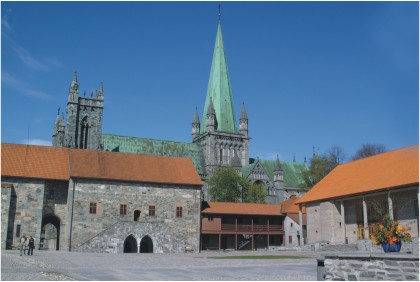
Back to top
GHGT-7 Proceedings
Due to circumstances beyond the organiser’s control, issue of the proceedings from the 7th International Conference on Greenhouse Gas Control Technologies has been delayed. Delegates of the conference will receive their copy of the proceedings by the end of November. We apologize for the delay.
The Greenhouse Gas Control Technologies conference series has established itself as the foremost conference bringing together the international energy community, providing a forum for the discussion of the latest advances in the field of greenhouse gas control technologies.
Orders for the proceedings can be placed with the publishers, Elsevier. (www.elsevier.com)
ISBN: 0-08-044704-X, 2700 pages Prices: EUR 220, USD 300, GBP 150
Back to top
Good News for CO2 Storage from the IMO
The 27th Consultative meeting of the Contracting Parties to the London Convention was held at the International Maritime Organisation (IMO) headquarters 24th-28th October 2005. The meeting “acknowledged that CO2 sequestration in sub-seabed geological structures had a role to play, as part of a suite of measures to tackle the challenge of climate change and ocean acidification” This is an important step towards clearly establishing the legality of off-shore CO2 storage.
The meeting noted a report by the IMO’s Technical Working Group on CO2 Sequestration which had concluded that CO2 sequestration in sub-seabed geological structures was technically feasible and that a considerable body of evidence and experience existed on CO2 sequestration, including sequestration technologies, technical mitigation options for CO2 leakage and monitoring methods.
It was noted that there were gaps in the knowledge related to possible impacts on the marine environment and in technology, such as monitoring techniques. The meeting decided that it would be necessary to develop an assessment framework for the evaluation and management of potential risks to the environment. To further this work the meeting agreed to establish a ‘Science Group – Intersessional Technical Working Group on CO2 Sequestration’. The group will be led by the USA and is scheduled to meet from 3rd-7th April 2006.
Following a review and analysis of the views of Contracting Parties that was prepared by the UK; other points of agreement from the meeting on this issue were:
- It was agreed that the London Convention and Protocol, which provide the specific global framework for the protection of the marine environment against pollution from dumping at sea, were appropriate global instruments to address the implications of CO2 sequestration in sub-seabed geological structures for the marine environment;
- It was recognised that there were varying interpretations of how the Convention and Protocol apply in different circumstances to CO2 sequestration in sub-seabed geological structures;
- It was decided that it was desirable to consider options for facilitating and / or regulating CO2 sequestration in sub- seabed geological structures including clarification (and, if appropriate, amendment) of the Protocol and the Convention;
- It was agreed to convene the ‘Intersessional Legal and Related Issues Working Group on CO2 Sequestration’, to develop a menu of options to clarify (and, if appropriate amend) the Protocol and Convention, with a view to facilitating and/or regulating the use of CO2 sequestration in sub-seabed geological structures. (This working group is tentatively scheduled to meet from 10th-13th April 2006.)
The next (28th) Consultative Meeting will consider how best to facilitate and/or regulate CO2 sequestration in sub-seabed geological structures.
Back to top
18th World Petroleum Congress
IEA GHG was invited to lead a round-table at the congress on Climate Change Initiatives. The sub-title was 'public perception'. Taking part in the round table with IEAGHG's Harry Audus were: Lars Ingolf Eide representing the Carbon capture Project, Rob Cormie, Director Cooperate Finance, KPMG, and Steve Lennon, MD Resources and Strategy, Eskom representing the World Energy Council. There was a general acceptance from the audience at the round table that climate change was an issue that the oil industry had to do something about. Most of the discussion was on what was needed to make carbon capture and storage happen. Perhaps not surprisingly this 'public' audience of oil industry people did not see storage of CO2 underground as being particularly difficult or of much concern.
Much of the conference discussion was on the need for infrastructure development of new hydrocarbon resources in an uncertain financial climate. Some papers dealt with revisiting old 'brown-field' sites with new well patterns – which raises issues for CCS on the possibility of CO2 storage in 'depleted' oil fields. CCS issues were well to the fore and discussed in a number of sessions. CO2 for EOR was very topical, the main issue being how to make the financial incentives work. There were also several advocates of working towards a 'hydrogen economy' but there was a strong reaction from some that hydrogen was always going to be too expensive to use as an energy carrier.
The next WPC Congress will be in Madrid in 2008. www.world-petroleum.org/
Back to top
Oxy-Fuel Combustion
The topic of Oxy-fuel combustion is attracting much interest. We reported in Greenhouse Issues, number 78, on Vattenfall’s plans to build a pilot plant near Berlin, and in the last issue (number 79), on a planned meeting aimed at forming an IEA GHG International Network to promote dialogue between research groups active in oxy-fuel R&D.
At the time of writing, this meeting (to be held 29th and 30th November) was over-subscribed and we could not cope with any more attendees. The outcome of the meeting will be reported in the next Newsletter.
Readers potentially interested in this area should refer to the Greenhouse Cuttings section on Total and Alstom.
Back to top
Third Trondheim Conference on CO2 Capture, Transport and Storage
By Olav Bolland, NTNU
The 3rd Trondheim Conference on CO2 capture, transport and storage was held 10th-11th October 2005. It was attended by about 100 people and hot topics this year were policies for CCS to happen in Norway and globally, and novel developments in CO2 capture technologies.
The opening session was chaired by Nils Røkke and included key speakers from CICERO, SINTEF, IEA-GHG, GASSNOVA, US-DoE and BELLONA( NGO). Pål Prestrud (CICERO) set the scene by pointing out that in Norway and the Arctic, we will see almost a doubling in temperature increase compared to global average increases. Bjørn Erik Haugan (GASSNOVA) gave a survey of national funding instruments for CO2 related R&D and Demonstration- a total of about 18m€ is available per annum for such efforts. John Gale gave an overview of the IPCC summary report on CO2; although wide ranges and options are given- CCS is concluded to have a large potential impact for CO2 mitigation.
We also learned about the bi-lateral agreements within CCS between US and Norway and the US/NO Late summer school on CO2 which was arranged as part of the event from Pamela Tomski. Both Gunnar Sand (SINTEF) and Fredric Hauge (Bellona) stressed the importance of starting with real actions within CCS and Bellona referred to their recently released report for CO2 management.
In addition to the scientific part of the conference, a guided tour to the Archbishops Yard was included; this is the reception area for next year’s GHGT-8 conference.
The proceedings and programme from the Third Trondheim Conference can be found at www.energy.sintef.no/arr/
CO2_2005/



